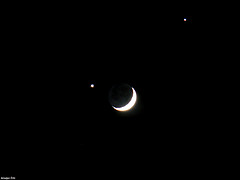 The September night sky is thrilling this year. September 24 is the equinox, and the full moon of the fall equinox is the brightest and biggest of the year. In the southeast sky the moon will be waning, after the full moon of the 24th. Southeast from Brooklyn is generally towards Coney Island and slightly towards sunrise. Most auspicious is the appearance of Jupiter in the southeast sky. It has not been this bright in our sky since 1963. It looks like a bright star, and you might think at first that it is a hovering helicopter. Planets appear bigger and brighter than stars because they are in our solar system and are closer to us. Stars are usually bigger than the planets, but they are light years away in the vast universe.
The September night sky is thrilling this year. September 24 is the equinox, and the full moon of the fall equinox is the brightest and biggest of the year. In the southeast sky the moon will be waning, after the full moon of the 24th. Southeast from Brooklyn is generally towards Coney Island and slightly towards sunrise. Most auspicious is the appearance of Jupiter in the southeast sky. It has not been this bright in our sky since 1963. It looks like a bright star, and you might think at first that it is a hovering helicopter. Planets appear bigger and brighter than stars because they are in our solar system and are closer to us. Stars are usually bigger than the planets, but they are light years away in the vast universe.
I sighted Jupiter easily at 8:30 pm Monday Sept. 21 in the southeast sky, without binoculars or a telescope, on Ocean Parkway. If the moon had a clock on it, you could find the 7 or 8 and then imagine a diagonal line down to the left from it to find Jupiter. You can find an open slice of sky near the park, on a playground or broad avenue or plaza. I saw Jupiter above buildings 4-6 stories high
In the northern sky we see the Big Dipper, which is part of Ursa Major. The stars in the handle of the Big Dipper point west, and those 3 stars are the brightest. Due to light pollution, the pan part of the Big Dipper is harder to see, as it is closer to our horizon. The two stars at the eastern side of the Big Dipper point straight north to Polaris, our Pole star, also called the North Star. Polaris is not the brightest star, but it can be seen above the glare of the city lights, such as from a higher floor.
If you follow the curve of the handle of the Big Dipper to the west (left, as you are facing north to it) you will find a bright star, Arcturus. Arcturus is part of Bootes, a constellation in the west that looks like a kite. The other stars in Bootes are hard to see in the city glare, but can be made out on a clear dark night. Arcturus is one of the brightest stars in our sky. It is the zenith star for Hawaii.
Our brightest zenith star is Vega, and if you look straight up at about 7:15 pm, it is the first star to appear. It is in the constellation of Lyra, the Harp. If you look up while facing north a bit later, say 7:45, you will see the next brightest zenith star, Deneb. Deneb is in the constellation of Cygnus, the Swan. It is also called the Northern Cross. These stars can be seen even here with the unaided eye. Children may be able to see more stars than we can, as we lose some of our acuity for low light as we age. Cygnus is slightly east of Vega/Lyra, and most of the stars in the constellation can be seen by about 8:30 pm in our sky.
For more information about the night sky, and wonderful videos of the sky and telescope views, look up the following web sites:
The Old Farmers Almanac also has a trove of information, as does the Hubble Telescope site.
Happy stargazing!
Ms. Karen
***Update from Karen: The position of Jupiter may be to the right or south of the moon now in the evening sky. It changes daily, with the orbits of the moon, earth and Jupiter itself changing positions in our sky.
